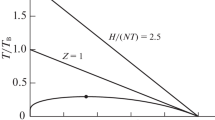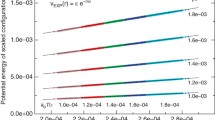Abstract
The properties of an expansion of the statistical sum of a simple liquid with respect to the potential in thermodynamic perturbation theory are analyzed. The coefficients of this expansion are determined by the unperturbed potential, depend on temperature and density, and can be calculated by means of mathematical modeling. It is shown here that the derivatives of these coefficients with respect to temperature and density are expressed through the higher expansion coefficient (these relations are usually called a hierarchy of equations). These coefficients determine the expansion of the Helmholtz free energy and RDF with respect to the perturbation potential. The thermodynamic characteristics of the system (entropy, internal energy, pressure) are expressed through both the differential relations for the Helmholtz free energy and the integral expressions containing RDF. It is found that the hierarchy of equations obtained in this work makes these different methods equivalent. This is important for the application of thermodynamic perturbation theory because it becomes unnecessary to model any other equilibrium properties of the system apart from the expansion coefficients.
Similar content being viewed by others
References
H. N. V. Temperley, J. S. Rowlinson, and G. S. Rushbrooke, Physics of Simple Liquids, North Holland Amsterdam (1968).
J. D. Weeks, D. Chandler, and H. C. Andersen, J. Chem. Phys., 30, No. 12, 5237–5247 (1971).
H. C. Andersen, J. D. Weeks, and D. Chandler, Phys. Rev A, 4, No. 4, 1597–1607 (1971).
L. Verlet and J.-J. Weis, Phys. Rev. A, 5, No. 2, 939–952 (1972).
F. H. Ree, J. Chem. Phys., 64, No. 11, 4601–4605 (1976).
M. Ross, J. Chem. Phys., 71, No. 4, 1567–1571 (1979).
F. Lado, Mol. Phys., 52, No. 4, 871–876 (1984).
H. S. Kang, S. C. Lee, and T. Ree, J. Chem. Phys., 82, No. 1, 415–423 (1985).
L. D. Landau and E. M. Lifshits, Statistical Physics [in Russian], P. 1. 5th ed., Fizmatlit, Moscow (2005).
Yu. T. Pavlyukhin, J. Struct. Chem., 50, No. 3, 446–455 (2009).
J. A. Barker and D. Henderson, Rev. Mod. Phys., 48, No. 4, 587–673 (1976).
P. Balescu, Equilibrium and Nonequilibrium Statistical Mechanics, Wiley, New York (1975).
J. A. Barker and D. Henderson, J. Chem. Phys., 47, No. 8, 2856–2861 (1967).
Yu. T. Pavlyukhin, J. Struct. Chem., 51, No. 1, 60–68 (2010).
Yu. T. Pavlyukhin, J. Struct. Chem., 47,Suppl., S173–S190 (2006).
B. J. Alder, D. A. Young, and M. A. Mark, J. Chem. Phys., 56, No. 6, 3013–3029 (1971).
W. R. Smith, D. Henderson, and J. A. Barker, J. Chem. Phys., 55, No. 8, 4027–4033 (1971).
Yu. T. Pavlyukhin, J. Struct. Chem., 48, No. 1, 74–80 (2007).
Yu. T. Pavlyukhin, J. Struct. Chem., 48, No. 6, 1073–1081 (2007).
V. P. Leonov and A. N. Shiryaev, Teoriya Veroyatnosti i Primen., 4, No. 3, 342–355 (1959).
Yu. V. Prokhorov and Yu. A. Rozanov, Probability Theory: Main Conceptions, Limiting Theorems, Random Processes [in Russian], Nauka, Moscow (1967).
Author information
Authors and Affiliations
Corresponding author
Additional information
Original Russian Text Copyright © 2011 by Yu. T. Pavlyukhin
__________
Translated from Zhurnal Strukturnoi Khimii, Vol. 52, No. 4, pp. 748–758, July–August, 2011.
Rights and permissions
About this article
Cite this article
Pavlyukhin, Y.T. Thermodynamic perturbation theory of simple liquids. A hierarchy of equations for expansion coefficients. J Struct Chem 52, 726–736 (2011). https://doi.org/10.1134/S0022476611040123
Received:
Published:
Issue Date:
DOI: https://doi.org/10.1134/S0022476611040123




